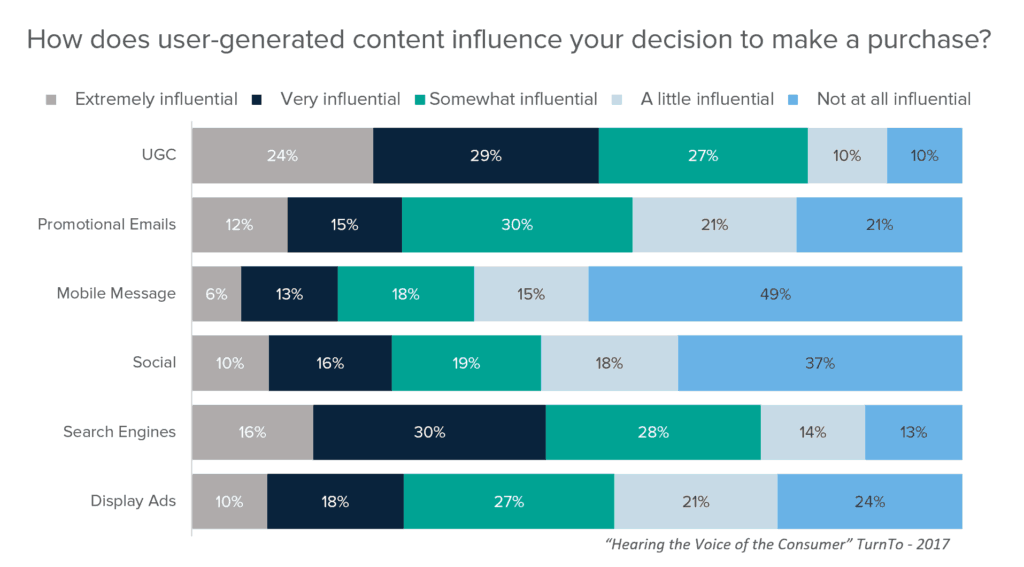
Jim Davidson, director of research, TurnTo Networks
Engaged shoppers. Repeat customers. Low abandonment. High conversion. The measures of commerce success can seem simple when distilled down to a few words. However, it’s just an illusion. We know the complexities that come with a successful commerce strategy.
Consumers have shorter attention spans. Another illusion. Consumers have limitless shopping choices and they own the devices to find the best deals and most engaging shopping experiences. They are in control and loyalty can often vaporize when the shopping experience doesn’t meet expectations.
“Free Shipping” was one of the first flags that marketers waved to keep consumers focused and shopping. This was enough of an incentive for a few years. Now free shipping is table stakes.
Next came the deep discounts. Just look at the growing number of retailers who will offer 50% off everything for most of the holiday season. These price cuts may bring in the sales, but can kill your bottom line.
What happens now that shoppers expect prices to be slashed and for speedy shipping to be free? How can marketers keep shoppers engaged, progressing toward a purchase and coming back for more?
Consumers clearly shop differently than they did only a few years ago. They communicate differently too. Social engagement, validation and interactions dominate many of the most-used mobile apps and web sites. Phone calls have become text messages. Fellow shoppers have become trustworthy resources and not scary strangers on the internet.
Marketers can connect their commerce strategies to this communication concept by improving user-generated content programs and exploring new ways to solicit and feature UGC throughout the customer journey.
When U.S. shoppers were asked how various commerce strategies influence their purchase decisions, UGC was rated the most influential – outranking other marketing levers such as email, mobile messages and search. (“Hearing the Voice of the Consumer” – TurnTo, 2017)
 Whether you are starting your holiday planning or just looking to boost some summer sales, take the time to consider how user-generated content could help you to tap into this evolving consumer behavior.
Whether you are starting your holiday planning or just looking to boost some summer sales, take the time to consider how user-generated content could help you to tap into this evolving consumer behavior.
Here are a few strategies to get started.
Location, Location, Location
Your UGC programs are not going to work if they are sitting stagnant and collecting dust on your product pages. Step through the purchase path and identify opportunities to feature UGC. Feature star ratings in search results. Receive syndicated review content from your top brands to boost your UGC resources. Decrease cart abandonment rates by including checkout comments and review excerpts in the cart and checkout process. Use UGC in cart reminder emails to offer a softer sale.
As you step through the customer journey, reexamine your UGC collection strategies. There’s more to UGC solicitation than the standard post-purchase review request email. Encourage shoppers to ask questions. Invite customers to provide answers. Ask shoppers why they purchase certain products on the order confirmation page.
Friction-Fighting Forms
Standard, site-based web forms will never fully go extinct, but they are not the only way for you to collect user-generated content. If your UGC submission rates are low, it may be time to rethink your UGC collection efforts and catch up to current consumer behavioral trends and the technology shoppers use.
Fight the friction and beat those barriers that can decrease UGC submission rates by putting rating and review forms in the body of an email. New innovations in email-based forms mean a stable experience for the opener and one less step between their inbox and their UGC submission.
Include links that directly open a phone’s camera so customers can quickly add photos of products they have purchased.
Cultivate the Conversations
Negative reviews, few ratings, no customer submitted photos… These are common concerns for many marketers. In fact, these are often the reasons given for not expanding UGC efforts. Marketers need to foster, not force, the conversations and interactions between shoppers. You can add to the conversation, but you shouldn’t try to control the dynamic.
Taking this approach can build trust with your shoppers. This broad spectrum between your positive and negative product reviews can set clearer expectations with your shoppers and help them to buy with confidence.
To truly future-proof your marketing efforts, you must advance your UGC strategies. If you need more evidence that this could be the connection between your shopper and a sale, consider another stat from the study mentioned above. The majority of U.S. shoppers (81%) say they would pay more and wait longer to receive products that are coupled with UGC compared to the same product without UGC.
As the holidays approach, are you ready to get the sale from that 81% of shoppers? Focus on building your UGC strategy so you are confident that you aren’t giving your shoppers a reason to click or tap away to your competitor looking for the same item that is paired with UGC.
TurnTo Networks enables online retailers to present customer feedback in the form of question-and-answer forums, ratings and reviews, comments at checkout and visual reviews.